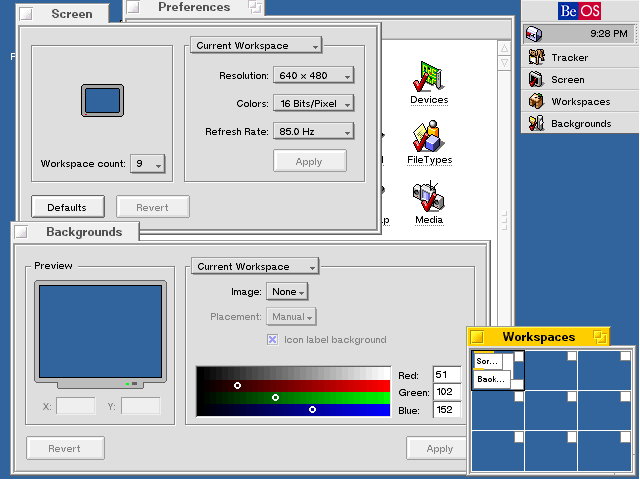|
|
Location: GUIs >
BeOS 5.0 Personal Edition screen shots.
BeOS is a powerful OS designed primarily for Multimedia desktop use. Originally BeOS was designed for a custom computer system known as the BeBox that had special multimedia input/output features, and was later ported to the Macintosh, and finally ported to the PC. This version of BeOS is the Personal Edition, which can be downloaded freely from the Internet and installed under Windows. Under Windows 95 and Windows 98 you can just double click an icon to exit Windows and start this version of BeOS. On ME or NT 4 or later you can use a boot floppy to start the installed BeOS. Unfortunately Be ran in to problems competing with Microsoft, such as Microsoft's license agreements with OEMs that forbid them from selling computers that booted more than one OS. In 2001 after changing their focus to "internet appliances", Be went out of business.
BeOS is a vaguely Unix-ish OS, but is single-user with no local security restrictions. Over all its GUI rivals that of Microsoft Windows and MacOS.
Clicking on the BeOS logo on the Deskbar brings up a menu with programs you can run. The Deskbar can also be dragged to other corners of the screen or to the upper or lower of the screen to give it a "Windows task bar" appearance. Running programs appear on the Deskbar. If a program has multiple windows only one icon is shown but clicking on the program icon displays a list of open windows you can select from. The Tracker is the file manager used by BeOS and is equivalent to the Windows 95 Explorer or the MacOS finder. It can view files as normal icons, a list of small icons or in a detailed view. (No pointless "web" view thanks goodness) Although much of BeOS has a MacOS feel to it the windowing system places menus in each window rather than at the top.
BeOS offers virtual desktops called "workspaces". Each workspace may have its own background and screen resolution. It is possible to configure the number of available workspaces.
Some of the default icons on the desktop were links to the Be web site, however as you can see the Be web site is long gone. |



